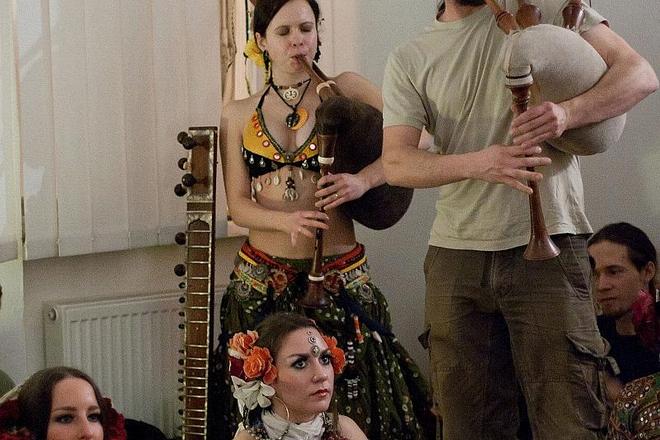ON THE freezing night of February 4 an oasis of warmth appeared in downtown Bratislava – and not just thanks to good heating in the My a mama (Us and Mom) teahouse and the thick air within the packed space. Rather the exotic music emanating from within the teahouse and scantily-clad ladies dancing eagerly to its rhythms evoked the atmosphere of a Bedouin tribal reunion somewhere in a sun-scorched desert.
“Interactive Dance Evening” as the event was called in the programme, offered improvised performances by the Rustiqua dance group and the Pressburger Tribal Society. Rustiqua essentially consists of three young ladies dancing the American Tribal Style Belly Dance, sometimes known simply as ATS or Tribal, a dance style that emerged in the western United States in the late 1980s based on movements originating in Mediterranean Africa and the Middle East. The Pressburger Tribal Society is a group of students, followers and fans gathered around Rustiqua.
Tribal dance represents “controlled group improvisation” in which the leader – usually on the left front side of the dancing group – gives signs invisible to the audience that guide the other dancers in following the leader’s moves. In practice, what seems like a strictly-trained choreography becomes mostly improvisation requiring a lot of movement and also a kind of tribal sense and empathy. The evening offered some solo dances as well, which underlined the differing individual styles of the performers, but for much of the night the dancers were in a group of four with the lead dancer rotating.
The non-competitive atmosphere among the dancers and the good vibes emanating from everyone in attendance gave the strongest imprint – except for the live music. Music plays a critical role in all types of Oriental events and the live music at the teahouse added immeasurably to the atmosphere. Some members of Rustiqua and the Pressbruger Tribal Society played various percussions as well as zills (finger cymbals) but a bagpipe became the highlight of the music. Though a Slovak bagpipe, it could have easily been mistaken for a Tadghtita, a Bedouin bagpipe, or some other kind of bagpipe used across North Africa. So when the Slovak folklore piece Tota Heľpa resounded through the audience, though in a slightly less well-known arrangement, and the women of the tribe danced in their exotic way, it was like being taken far, far away from the cold chill of that February night in Bratislava.



 (source: Peter Palenčár)
(source: Peter Palenčár)